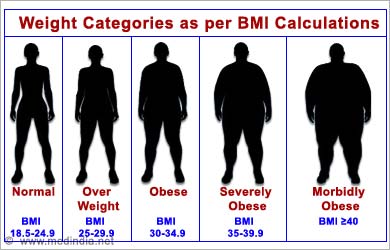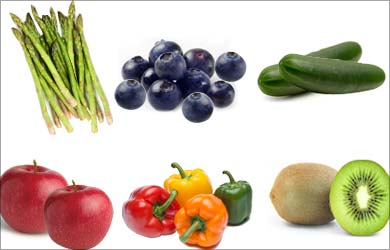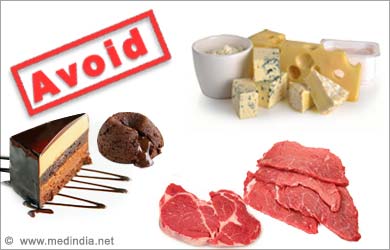| Fruits, Vegetables for Healthy Weight Loss Nov 14th 2013, 11:55
But in today's fast-paced life, people hardly have enough time to take care of themselves. One signal that the body sends to convey the message that all is not well with it is through an increase in body weight. Unchecked increase in body weight ultimately leads to obesity and this invites a plethora of diseases and ailments such as heart disease, high blood pressure, diabetes, high cholesterol. What follows next is the act of pressing the panic button and then starts the journey to lose weight. 
A balanced diet is very essential for overall well-being, but these days junk food is widely preferred, forget about sticking to a healthy diet. People are also adopting new lifestyle trends which are eventually taking a toll on them in the form of overweight and obesity. But in spite of getting red signals, people do not sit up to take care of themselves until the situation spirals out of hand.Measuring Body weight Extra body weight from muscle, bone, fat, and/or water describes the word overweight, whereas obesity is the high amount of extra body fat. Body Mass Index (BMI) measures the body fat on the basis of height and weight of adults. A BMI of less than 18.5 indicates the person is under weight. BMI ranging between 18.5 and 24.9 means normal weight, a BMI between 25 and 29.9 means overweight and a figure of 30 or greater indicates obesity. 
Healthy Way to Lose WeightThe National Institutes of Health website states that to achieve the goal of weight loss you should also bring about changes in lifestyle, along with adopting a healthy eating plan, keeping an eye on portion sizes and being physically active. According to researchers, in order to lose weight, one should keep the long-term benefits in mind, especially when taking to new eating habits. If the new habit is associated to short-term weight-loss programme, it will not be effective and long-lasting. A recent study also says that for a healthy weight loss, people should stress on consuming low-calorie foods such as fruits and vegetables. One should give up on a sedentary lifestyle as it is from here that all the problems originate. 
Fruits, vegetables and Weight Loss.To shed weight, the intake of calories should be fewer than what is being burnt. Thus, while aiming to lose weight, a person should eat food items that are low in energy density. Energy density is simply the number of calories found in a food. High energy density denotes lot of calories in the food, whereas low energy density means few calories in a food. When a food has 0.7 to 1.5 calories per gram, it denotes low energy, while very low energy density lies between 0 and 0.6 calories per gram. Some of the vegetables that help in weight loss are asparagus, cucumber, green beans, spinach, lettuce, bell peppers, radishes, onions, broccoli, cauliflower and mushrooms. These items help as they have low energy density. Some fruits that help in weight loss include apples, peaches, nectarines, kiwi fruit, grapefruit, cantaloupe and berries - raspberries, strawberries or blueberries. Even these come under the low-density category. These foods make you feel full and fight hunger, along with containing vitamins and minerals, very essential to our balanced diet, and giving us a lot of nutrition. They also contain antioxidants which help in preventing various diseases such as cancer, cardio-vascular diseases, age-related diseases. We should start a meal with fruits but not take fruits after meals as they tend to interfere with the digestion. 
To relish all the various nutrients, we should eat fruits and vegetables of many different colours. The five main colour groups are – red, orange/yellow, green, white, blue/purple.A cup of spinach contains only 7 calories. When 100 gm of broccoli is consumed, you get only 34 calories. 100 gm of beans has 31 calories. In 100 gm radish, there are 16 calories. 100 gm of cauliflower has 31 calories. 100 gm of asparagus has 25 calories, while 100 gm of mushroom has 38 calories. You get 34 calories in 100 gm of cantaloupe which is a rich source of Vitamins A and C, while 100 gm of grapefruit has 42 calories. 
How Fruits and Vegetables help to Lose WeightWhile following a weight-loss programme, your diet should include more of vegetables and fruits as they are low in density. Due to this characteristic, you feel full on eating them and in turn also consume lower calories. Fruits and vegetables are ideal diet for weight loss as they comprise water and fibre which increase their volume and reduce energy density. And a study says that it is not the calories in the food that force people to put a stop to eating, but it is the volume of food that plays the trick. As per a new study, researchers found that overweight people lost more weight when they took to lower-calorie foods, than those who were concerned only about bringing down overall calories. Many people also prefer to take fruit juices while trying to lose weight, but this will not help much as whole fruits are more satiating than fruit juices. The fibre content, which is usually lost in juices, also plays a role in making one feel full and thus helping in weight loss. The fibre also aids in weight regulation, along with keeping heart diseases and type 2 diabetes at bay. 
National Cancer Institute and Centres for Disease Control and Prevention have also said that including more vegetables and fruits in diet proves effective in weight management. And when people switch to a minimum of five cups of fruits and vegetables per day by replacing higher calorie foods with lower calories of vegetables and fruits, they tend to feel more full and satisfied. The American Heart Association says we should eat eight or more fruit and vegetable servings daily. In a day, an average adult taking in 2,000 calories should usually take 4.5 cups of fruits and vegetables.Weight Loss in Women Post Menopause According to a study published in Journal of the Academy of Nutrition and Dietetics in 2012, eating more fruits and vegetables, skipping meat, cheese, desserts and bidding goodbye to a sedentary lifestyle is a sure-shot method for women to lose weight after menopause. Sticking to this diet will also benefit in the long-run. When women start losing weight at this stage, they also get self motivated more to eat what is right. 
Weight Loss in Women after Child BirthAt least five portions of fruits and vegetables a day, along with fibre-rich foods and whole grain meals work like a magic for women after child birth in shedding weight gradually, without affecting her overall health. 
Weight Loss in TeenagersThe problem of obesity in children and adolescents is a widespread problem today. Lifestyle and wrong food habits are to be highly blamed for this 'epidemic'. It is important to keep an eye on children from the very beginning otherwise extreme steps will have to be taken later. A healthy eating habit for children should include fruits and vegetables in the daily meal. They should be made to understand the advantages of eating fruits and vegetables and how these foods work towards maintaining a healthy body. Weight Management Weight management is another important aspect of the weight-loss plan. And to deal with the right amount of calorie intake, you need to keep a watch on portion sizes. Physical activity should be made a part of the lifestyle to control weight. You should also include healthy snacks in your diet. Just exercises without a control on the diet will not yield any long-term result. 
 |  |
No comments:
Post a Comment